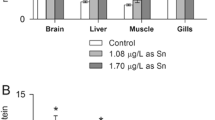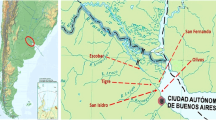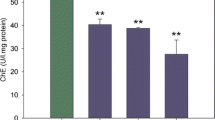Abstract
Triphenyltin (TPhT) is used worldwide in pesticide formulas for agriculture. Toxic effects of this compound to aquatic life have been reported; however, the biochemical response of fish exposed to different concentrations of TPhT hydroxide (TPhTH) was investigated for the first time in this study. The lethal concentration (LC50) of TPhTH to silver catfish, Rhamdia quelen, was calculated from an acute-exposure experiment (96 h). In addition, acethylcholinesterase (AChE) activity in brain and muscle—as well as glucose, glycogen, lactate, total protein, ammonia, and free amino acids in liver and muscle—were evaluated in a chronic-exposure experiment (15-day exposure). Speciation analysis of tin (Sn) was performed in fish tissues at the end of both experiments using gas chromatography coupled to a pulsed-flame photometric detector (GC-PFPD). Concentrations of TPhT, diphenyltin, and monophenyltin (reported as Sn) were lower than limits of quantification (10σ criteria). Waterborne TPhTH concentration used through the experiment was also evaluated by GC-PFPD, and no degradation of this species was observed. The LC50 value for silver catfish juveniles was 9.73 μg L−1 (as Sn). Decreased brain and muscle AChE activities were observed in fish exposed to TPhTH in relation to unexposed fish (control). Liver glycogen and lactate levels were significantly higher in fish kept at the highest waterborne TPhTH concentration compared with the control. Liver and muscle glucose levels of fish exposed to all TPhTH concentrations were significantly lower than those of control fish. Silver catfish exposed to all TPhTH concentrations showed lower total protein values and higher total free amino acids levels in liver and muscle compared with controls. Total ammonia levels in liver and muscle were significantly higher for the highest TPhTH concentration compared with controls. In conclusion, TPhTH caused metabolic alterations in silver catfish juveniles, and the analyzed parameters can also be used as bioindicators for TPhTH contamination.




Similar content being viewed by others
References
Antes FG, Krupp E, Flores EMM, Feldmann J, Dressler VL (2012) Speciation and degradation of triphenyltin in typical paddy fields and its uptake into rice plants. Environ Sci Technol 45:10524–10530
Appel KE (2004) Organotin compounds: toxicokinetic aspects. Drug Metab Rev 36:763–786
Becker AG, Moraes BS, Menezes CC, Loro VL, Santos DR, Reichert JM et al (2009) Pesticide contamination of water alters the metabolism of juvenile silver catfish, Rhamdia quelen. Ecotoxicol Environ Saf 72:1734–1739
Begum G (2004) Carbofuran insecticide induced biochemical alterations in liver and muscle tissues of the fish Clarias batrachus (Linnaeus) and recovery response. Aquat Toxicol 66:83–92
Begum G, Vijayaraghavan S (1999) Effect of acute exposure of the organophosphate insecticide rogor on some biochemical aspects of Clarias batrachus (Linnaeus). Environ Res 80:80–83
Bidinotto PM, Moraes G, Souza RHS (1998) Hepatic glycogen and glucose in eight tropical freshwater teleost fish: a procedure for field determinations of micro samples. Bol Téc CEPTA 10:53–60
Bock R (1981) Triphenyltin compounds and their degradation products. Res Rev 79:1–270
Boyd CE, Tucker CS (1992) Water quality and pond soil analyses for aquaculture. Alabama Agricultural Experiment Station, Auburn University, Auburn
Bradford MM (1976) A rapid and sensitive method for the quantification of microgram quantities of protein utilizing the principle of protein-dye binding. Anal Biochem 72:248–254
Bretaud S, Toutant JP, Saglio P (2000) Effects of carbofuran, diuron and nicosulfuron on acetylcholinesterase activity in goldfish (Carassius auratus). Ecotoxicol Environ Saf 47:117–124
Colt J (2002) List of spreadsheets prepared as a complement (Available in http://www.fisheries.org/afs/hatchery.html). In: Wedemeyer GA (ed) Fish hatchery management (2nd ed). American Fish Society Publication
Crestani M, Menezes C, Glusczak L, Miron DS, Lazzari R, Duarte MF et al (2006) Effects of clomazone herbicide on hematological and some parameters of protein and carbohydrate metabolism of silver catfish, Rhamdia quelen. Ecotoxicol Environ Saf 65:48–55
Crestani M, Menezes C, Glusczak L, Miron DS, Spanevello R, Silveira A et al (2007) Effect of clomazone herbicide on biochemical and histological aspects of silver catfish Rhamdia quelen and recovery pattern. Chemosphere 67:2305–2311
David M, Mushigeri SB, Shivakumar R, Philip GH (2004) Response of Cyprinus carpio (Linn) to sublethal concentration of cypermethrin: alterations in protein metabolic profiles. Chemosphere 56:347–352
de la Torre FR, Ferrari L, Salibián A (2002) Freshwater pollution biomarker: response of brain acetylcholinesterase activity in two fish species. Comp Biochem Physiol C: Toxicol Pharmacol 131:271–280
Dutta HM, Arends DA (2003) Effects of endosulfan on brain acetylcholinesterase activity in juvenile bluegill sunfish. Environ Res 91:157–162
Eaton AD, Clesceri LS, Rice EW, Greenberg AE (2005) Standard methods for the examination of water and wastewater (21st ed). American Public Health Association
Ellman GL, Courtney KD, Andres V Jr, Featherstone RM (1961) A new and rapid colorimetric determination of acetylcholinesterase activity. Biochem Pharmacol 7:88–95
Fernández-Vega C, Sancho E, Ferrando MD, Andreu E (2002) Thiobencarb induced changes in acetylcholinesterase activity of the fish Anguilla anguilla. Pest Biochem Physiol 72:55–63
Finney DJ (1971) Probit analysis. Cambridge University Press, Cambridge
Glusczak L, Miron DS, Crestani M, Fonseca MB, Pedron FA, Duarte MF et al (2006) Effect of glyphosate herbicide on acetylcholinesterase activity and metabolic and hematological parameters in piava (Leporinus obtusidens). Ecotoxicol Environ Saf 65:237–241
Glusczak L, Miron DS, Moraes BS, Simoes RR, Schetinger MRC, Morsch VM et al (2007) Acute effects of glyphosate herbicide on metabolic and enzymatic parameters of silver catfish (Rhamdia quelen). Comp Biochem Physiol C: Toxicol Pharmacol 146:519–524
Harrower JR, Brown CH (1972) Blood lactic acid. A micromethod adapted to field collection of microliter samples. J Appl Physiol 32:709–711
Hoch M (2001) Organotin compounds in the environment—an overview. Appl Geochem 16:719–743
Horiguchi T, Shiraishi H, Shimizu M, Morita M (1997) Effects of triphenyltin chloride and five other organotin compounds on the development of imposex in the rock shell, Thais clavigera. Environ Pollut 95:85–91
Jarvinen AW, Tanner DK, Kline ER, Knuth ML (1988) Acute and chronic toxicity of triphenyltin hydroxide to fathead minnows (Pimephales promelas) following brief or continuous exposure. Environ Pollut 52:289–301
Johnson WW, Finley MT (1980) Handbook of acute toxicity of chemicals to fish and aquatic invertebrates. Research Publication 137. United States Fish and Wildlife Service, United States Department of the Interior, Washington, DC
Lionetto MG, Caricato R, Giordano ME, Pascariello M, Marinosci L, Schettino T (2003) Integrated use of biomarkers (acetylcholinesterase and antioxidant enzymes activities) in Mytilus galloprovincialis and Mullus barbatus in an Italian coastal marine area. Mar Pollut Bull 46:324–330
Ministério da Agricultura (2012) http://agrofit.agricultura.gov.br/agrofit_cons/. Accessed 4 Jan 2012
Miron D, Crestani M, Schetinger RM, Morsch MV, Baldisserotto B, Tierno AM et al (2005) Effects of the herbicides clomazone, quinclorac, and metsulfuron methyl on acetylcholinesterase activity in the silver catfish (Rhamdia quelen) (Heptapteridae). Ecotoxicol Environ Saf 61:398–403
Modesto KA, Martinez CBR (2010) Roundup® causes oxidative stress in liver and inhibits acetylcholinesterase in muscle and brain of the fish Prochilodus lineatus. Chemosphere 78:294–299
Moorthy KS, Kasi Srinivasa Moorthy K, Kasi Reddy B, Swami SK, Chetty CS (1984) Changes in respiration andionic content in tissues of freshwater mussel exposed tomethylparathion toxicity. Toxicol Lett 21:287–291
Moraes BS, Loro VL, Glusczak L, Pretto A, Menezes C, Marchezan E et al (2007) Effects of four rice herbicides on some metabolic and toxicology parameters of teleost fish (Leporinus obtusidens). Chemosphere 68:1597–1601
Nakanishi T (2008) Endocrine disruption induced by organotin compounds; organotins function as a powerful agonist for nuclear receptors rather than an aromatase inhibitor. J Toxicol Sci 33:269–276
O’Halloran K, Ahokas JT, Wright PFA (1998) Response of fish immune cells to in vitro organotin exposures. Aquat Toxicol 40:141–156
Oruç EO, Üner N (1999) Effects of 2,4-Diaminon some parameters of protein and carbohydrate metabolism in the serum, muscle and liver of Cyprinus carpio. Environ Pollut 105:267–272
Osada S, Nishikawa J, Nakanishi T, Tanaka K, Nishihara T (2005) Some organotin compounds enhance histone acetyltransferase activity. Toxicol Lett 155:329–335
Park JT, Johnson MJ (1949) A submicro determination of glucose. J Biol Chem 181:149–151
Pereira-Maduenho L, Martinez CBR (2008) Acute effects of diflubenzuron on the freshwater fish Prochilodus lineatus. Comp Biochem Physiol C: Toxicol Pharmacol 148:265–275
Pretto A, Loro VL, Morsch VM, Moraes BS, Menezes C, Clasen B et al (2010) Acetylcholinesterase activity, lipid peroxidation, and bioaccumulation in silver catfish (Rhamdia quelen) exposed to cadmium. Arch Environ Contam Toxicol 58:1008–1014
Pretto A, Loro VL, Menezes C, Moraes BS, Reimche GB, Zanella R et al (2011) Commercial formulation containing quinclorac and metsulfuron-methyl herbicides inhibit acetylcholinesterase and induce biochemical alterations in tissues of Leporinus obtusidens. Ecotoxicol Environ Saf 74:336–341
Romani R, Antognelli C, Baldracchini F, de Santis A, Isani G, Giovannini E et al (2003) Increased acetylcholinesterase activities in specimens of Sparus auratus exposed to sublethal copper concentrations. Chem Biol Interact 145:321–329
Saglio P, Trijasse S (1998) Behavioral responses to atrazine and diuron in goldfish. Arch Environ Contam Toxicol 35:484–491
Sancho E, Ferrando MD, Andreu E (1997) Sublethal effects of an organophosphate insecticide on the European eel, Anguilla anguilla. Ecotoxicol Environ Saf 36:57–65
Sancho E, Ferrando DM, Fernández C, Andreu E (1998) Liver energy metabolism of Anguilla anguilla after exposure to fenitrothion. Ecotoxicol Environ Saf 41:168–175
Sancho E, Cerón JJ, Ferrando MD (2000) Cholinesterase activity and hematological parameters as biomarkers of sublethal molinate exposure in Anguilla anguilla. Ecotoxicol Environ Saf 46:81–86
Schaefer CH, Miura T, Dupras Jr EF, Wilder WH (1981) Environmental impact of the fungicide triphenyltin hydroxide after application to rice fields. J Econ Entomol 74:597–600
Senger MR, Rosemberg DB, Rico EP, Arizi MB, Dias RD, Bogo MR, Bonan CD (2006) In vitro effect of zinc and cadmium on acetylcholinesterase and ectonucleotidase activities in zebrafish (Danio rerio) brain. Toxicol In Vitro 20:954–958
Spies JR (1957) Colorimetric procedures for amino acids. Methods Enzymol 3:467–477
Tooby TE, Hursey PA, Alabaster JS (1975) The acute toxicity of 102 pesticides and miscellaneous substances to fish. Chem Indust 21:523–526
Üner N, Oruç EO, Sevgiler Y, Sahin N, Durmaz H, Usta D (2006) Effects of diazinon on acetylcholinesterase activity and lipid peroxidation in the brain of Oreochromis niloticus. Environ Toxicol Pharmacol 21:241–245
Van DN, Bui TTX, Tesfalidet S (2008) The transformation of phenyltin species during sample preparation of biological tissues using multi-isotope spike SSID-GC-ICPMS. Anal Bioanal Chem 392:737–747
Verdouw H, Vanechteld CJA, Deckkers EMJ (1978) Ammonia determinations based on indophenol formation with sodium salicylate. Water Res 12:399–402
Wieke Tas J, Hermens LM, Van den Berg M, Seinen W (1989) Bioconcentration and elimination of triphenyltin hydroxide in fish. Mar Environ Res 28:215–218
Zhang Z, Hu J, Zhen H, Wu X, Huang C (2008) Reproductive inhibition and transgenerational toxicity of triphenyltin on medaka (Oryzias latipes) at environmentally relevant tip levels. Environ Sci Technol 42:8133–8139
Acknowledgments
The authors thank the Conselho Nacional de Pesquisa e Desenvolvimento Científico for research fellowships to B. Baldisserotto, V. L. Loro, E. M. M. Flores, and V. L. Dressler. A. G. Becker, F. G. Antes, and B. Clasen received doctoral fellowships from Coordenação de Aperfeiçoamento de Pessoal de Nível Superior.
Conflict of interest
None.
Author information
Authors and Affiliations
Corresponding author
Rights and permissions
About this article
Cite this article
Antes, F.G., Becker, A.G., Parodi, T.V. et al. Toxicity of Triphenyltin Hydroxide to Fish. Arch Environ Contam Toxicol 65, 733–741 (2013). https://doi.org/10.1007/s00244-013-9944-y
Received:
Accepted:
Published:
Issue Date:
DOI: https://doi.org/10.1007/s00244-013-9944-y




